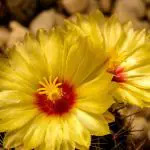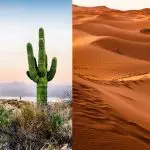Last Updated on March 2, 2023 by Derek
Desert plants have evolved to sustain themselves in high temperatures and with very little water. To reduce the loss of water through evaporation or transpiration the leaves of some desert plants have turned into spines. The epidermis of others has a thick layer of wax to cut down on the amount of water loss.
- Desert plants have evolved significantly to sustain the low amount of water and high temperatures.
- To reduce the amount of water loss through evaporation or transpiration the leaves have turned into spines.
- The epidermis of the leaves remains covered in thick wax to retain moisture.
- Also, the leaves are less porous to facilitate water retention in extreme temperatures.
What desert plants have waxy leaves?
Desert plants have a layer of thick waxy cuticles in the leaves. Instead of having porous leaves, it is a type of adoption that helps in transpiration and water retention.
Some of the common desert plants with waxy leaves include Privets, Camellias, Wax myrtle, etc.

Name some other plants with waxy leaves and stems
- Jade plant
- Anthurium
- Swiss cheese plant
- Mistletoe Fig
- Zanzibar gem
- Bromeliad
- Carissa Holly
What plants have thick waxy leaves?
The layer of waxy covering found on young stems, fruits, and leaves is referred to as the cuticle. It is composed of cutin, a wax-like compound that is a form of hydroxy fatty acid.
The primary purpose of this waxy coating is to help plants reduce water loss. In arid places, it is crucial for the survival of different plants.
On the other hand, the waxy compound help prevents disease-causing infections in wet regions. It is usually seen in the form of plates or a cluster of threads.
Sometimes the wax layer sits loosely on the leaves for easy passage of water vapor and gases. Also, plants may have a bluish coloration on the wax coating.
Plants with waxy leaves help to protect themselves from what?
The presence of a waxy covering on the leaf helps reduce the loss of water. It is particularly essential for plants growing in desert regions.
The layer of cuticle serves as the first line of armor for the plant against the natural surroundings. Also in some cases, it is known for protecting the plant from disease-causing microorganisms.
Why do most trees in semi-desert areas have waxy leaves?
As is known to everyone there are small pores on the surface of the leaf known as stomata. These take in carbon dioxide and release water vapor.
In desert regions, the stomata drive out fast as a consequence plants have small waxy leaves.
Cactuses are divided into leaves and produce food in the green stem. Desert plants are known for having wide-spreading, shallow root systems.
All these adaptations help prevent excess loss of water. Due to this desert plants can survive in environments with a scarcity of water.
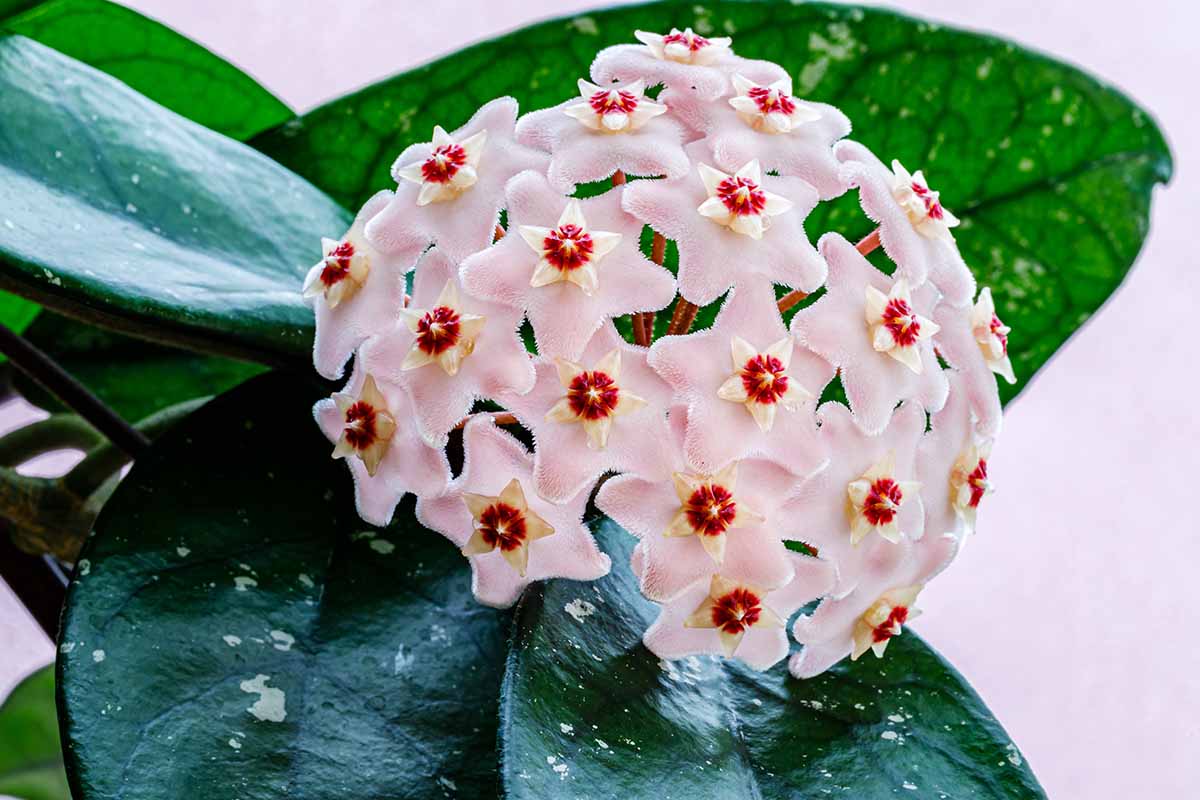
What are some outdoor plants with waxy leaves?
Following is a list of plants that look gorgeous due to the presence of glossy leaves.
- Wax plant
- Jade plant
- Dwarf umbrella tree
- Desert rose
- Peace lily
- Alocasia Polly
- Heart leaf philodendron
Everyone loves to have beautiful flowering plants in their homes. On the other hand, some plants look attractive because of their leaves.
One need not have trained eyes to observe plants with waxy leaves help enhance the beauty of the interiors. These plants can give any corner of the house an surprisingly natural and attractive look.
The glossy finish on the plants is because of the presence of cuticles. It is a protective layer on the outer surface made of a wax-like substance.
The cuticle layer has various benefits for the plant. It reduces the loss of excess water from the plant body. Also, it gives protection against insects, UV radiation, pollution, and mechanical stress.
Why do desert plants have thick and waxy stems?
Desert plants are mostly subjected to extremely high temperatures and very little water. To eliminate loss of water through evaporation or transpiration, the leaves, stems, and roots of these have evolved to survive in these conditions. The stem usually remains covered in a thick layer of waxy substance for preventing the loss of water.
The layer of epidermis on desert plants is usually thicker to lower the rate of water loss from the plant. All types of organisms are susceptible to drying up in a desert climate.
What is the name of the plant with waxy leaves and red flowers?
Anthurium plant is one of the most suitable tropical flowers. It is commonly seen in tropical regions. Bouquets made using these flowers are widely used at weddings and other occasions. Anthurium andreanum is commonly referred to as the tail flower.
It becomes more colorful during spring and fall. The glossy red heart-shaped flowers are spathes that can last for many days.
Each of these has a yellow or white spadix covered with the actual flowers. Some types feature spathes of different colors.
The plant is characterized by dark green leaves with a leathery texture. The leaves tend to grow up to a length of 8-20 cm.
| Common Name | Botanical Name | Soil pH Range | Soil Type | Sunshine | Growing Zones |
|---|---|---|---|---|---|
| Anthurium | Anthurium andraeanum | 5.5 – 6.5 | Well-draining, loose soil | Bright, indirect light | 10-12 |

It is known for containing chemicals like calcium oxalate that result in extreme burning inside the mouth. Therefore it is best to keep the plant away from small children and pets.
Anthurium plant is a perennial variety that can survive for several years with appropriate care. The plants bloom beautifully if they get some sunshine.
At least 4 hours of bright and moderate sunlight every day will keep the plant in the best condition. However direct sunlight is avoided as it can cause dryness and brown patches on the leaf.
What are some trees with waxy leaves?
The most common reason for wax-coated leaves includes the white wax tree or wax-leaved privet. It is a type of landscaping plant commonly found in places with warm climates.

| Common Name | Botanical Name | Soil pH Range | Soil Type | Sunshine | Growing Zones |
|---|---|---|---|---|---|
| White Wax Tree | Crataegus douglasii | 6.0 – 7.5 | Well-draining, sandy | Full sun to partial shade | 6-9 |
Originally it is a Japanese tree grown for its uses and berries. The stem juices help in the production of natural lacquer.
The Desert Willow is another tree known for having narrow waxy leaves. The tree also grows beautiful purple flowers. The flowers grow out on a stalk and have a waxy coating on the outside.
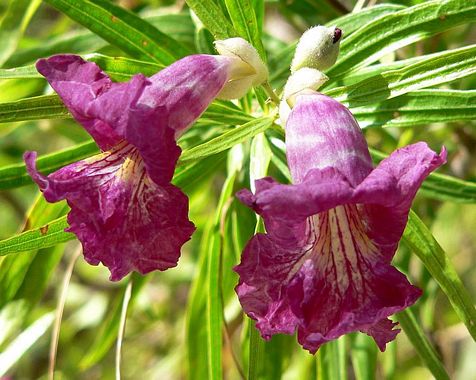
| Common Name | Botanical Name | Soil pH Range | Soil Type | Sunshine | Growing Zones |
|---|---|---|---|---|---|
| Desert Willow | Chilopsis linearis | 6.0 – 8.0 | Sandy, well-draining | Full sun | 7-11 |
Common waxy Leaf plant with white flower
Hoya Carnosa or the wax plant is a very popular house plant. People like it because of the pleasantly scented white flowers and waxy foliage.
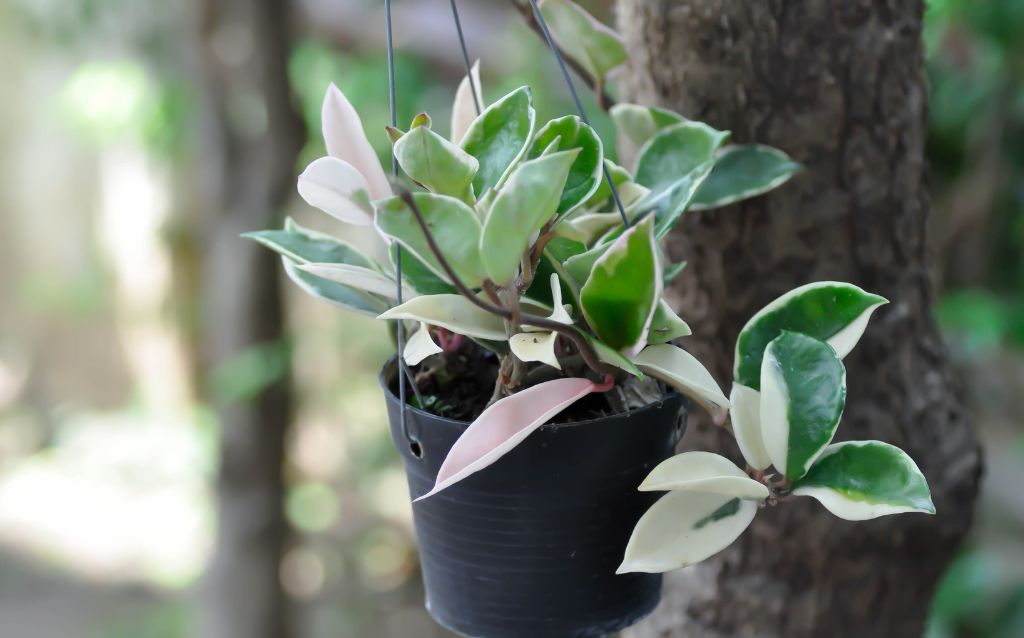
The plant is native to eastern Asia and Australia where it is called the porcelain flower. The appearance of the plant is much like artificial plant because of the shining leaves.
Hoya Carnosa is an extremely attractive plant for all kinds of interiors. It is known for beautiful clusters of scented flowers. There are numerous varieties of this tropical house plant. These are commonly referred to as spathe flowers or white sails.
| Common Name | Botanical Name | Soil pH Range | Soil Type | Sunshine | Growing Zones |
|---|---|---|---|---|---|
| Wax Plant | Hoya carnosa | 6.0 – 7.0 | Well-draining, porous | Partial to full shade | 10-12 |
For people who love to keep leafy house plants but have limited space, the Peace Lily turns out to be a perfect choice. These plants are mostly blue during the springtime. Flowers mostly blossom multiple times every year.

The blossom has the appearance of an open flag or the hood of a cobra. The white flowers create an excellent contrast with the dark leaves of the plant.
Peace Lily
| Common Name | Botanical Name | Soil pH Range | Soil Type | Sunshine | Growing Zones |
|---|---|---|---|---|---|
| Peace Lily | Spathiphyllum wallisii | 6.0 – 6.5 | Well-draining | Indirect light to shade | 10-12 |
Waxy leaf plant with pink flowers – Wax begonia
The wax begonia is a type of pot plant known for its white and pink flowers and waxy leaves. It is mostly a type of landscaping plant preferred by people in warmer climates.
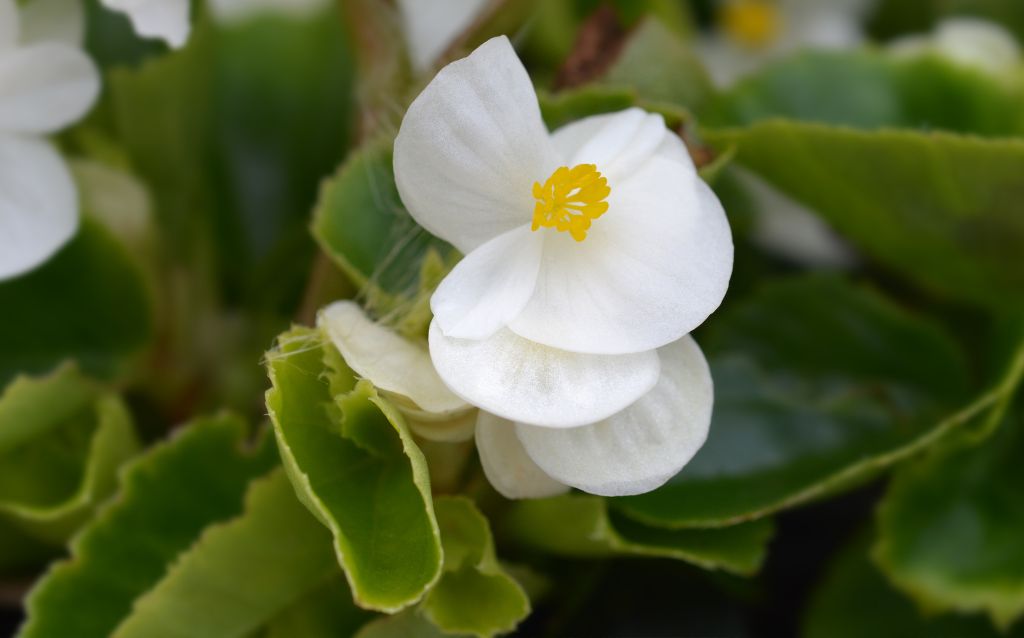
The plant is characterized by its thick succulent leaves. These leaves serve as a covering in arid regions. Some use it as a basket plant for the indoors. The shiny leaves and colored flowers make it a perfect choice for indoor decorations.
| Common Name | Botanical Name | Soil pH Range | Soil Type | Sunshine | Growing Zones |
|---|---|---|---|---|---|
| Wax Begonia | Begonia semperflorens | 6.0 – 7.0 | Well-draining | Partial to full shade | 10-11 |
5 government and education URLs about desert plants with waxy leaves:
- USDA Forest Service – Waxy-leaved Plants: https://www.fs.fed.us/wildflowers/ethnobotany/plants/waxy-leaved.shtml
- Arizona State University – Desert Plants with Waxy Leaves: https://askabiologist.asu.edu/desert-plants-waxy-leaves
- University of California Agriculture and Natural Resources – Waxy-leaved Plants: http://ipm.ucanr.edu/PMG/GARDEN/PLANTS/waxy.html
- Desert Botanical Garden – Plants with Waxy Leaves: https://www.dbg.org/gardening-horticulture/plants-waxy-leaves
- National Park Service – Desert Waxy-leaved Plants: https://www.nps.gov/articles/desert-waxy-leaved-plants.htm
FAQ relating to desert plants with waxy leaves
Why do desert plants have a waxy layer?
Desert plants usually have a thick layer of cutin to reduce water loss in a warm climate. The cutin is secreted from the epidermis of the leaf. The primary function of the waxy layer is to reduce and eliminate water loss from the leaf surface.
Why does desert vegetation have thorns and waxy leaves?
Normally plants lose moisture from the pores on the leaves and stem. As result desert plants have thorns and waxy leaves to reduce the loss of moisture.
In some plants, the leaves have taken the shape of thorns while others have a thick layer of wax.
What kind of leaves is found in desert plants?
Plants that grow in desert regions have spikes for leaves, small leaves, or a complete absence of leaves. Smaller or less number of leaves reduce water loss during transpiration as the surface area is less.
What kinds of plants are called desert plants?
Plants like Agave, Cactus, etc. have evolved to survive in an extreme desert climate. These plants can thrive with very little water.
The leaves are devoid of pores and become hard with spines or dry thrones. The spiny structures save water by not letting out the moisture content.


